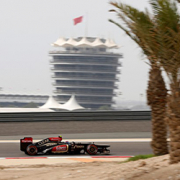Bahrain session 2 – A dry run for Melbourne?
 Starting from tomorrow until Sunday March 2nd, teams and drivers will be at work again at the Sakhir-based circuit, for the last pre-season session. It will be the last session before the official start of the 2014 Formula 1 World Championship at the Melbourne-based circuit.
Starting from tomorrow until Sunday March 2nd, teams and drivers will be at work again at the Sakhir-based circuit, for the last pre-season session. It will be the last session before the official start of the 2014 Formula 1 World Championship at the Melbourne-based circuit.
All teams will have to make a great effort and do a lot of work in order to identify and solve as many technical issues as possible.
 Last week we saw how vulnerable cars are and how long it takes to repair them. That could cause troubles during race week ends. The Bahrain-4-day-session will be the last chance for teams to try to push the new power unit to the limit. No team has managed to get the most of all the 15000 rpm. available (the best teams were able to exploit 14.000 rpm.) and of the energy recovery systems. In the previous session, all the Renault-powered teams had to lap without using the KERS, in order to run as many laps as possible. Despite that, teams still had many problems. Helmut Marko admits difficulties “We still have to solve many complicated problems. We’re so behind with the work and each time we find out new issues.” Red Bull only managed to run 116 laps, Toro Rosso ran 139 laps and Lotus ran 111 laps. Only the Caterham of Kobayashi and the rookie driver Ericsson managed to run more than 200 laps, even though test times were not quick at all. The Japanese driver stated that his CT05 is currently slower than a GP2 car.
Last week we saw how vulnerable cars are and how long it takes to repair them. That could cause troubles during race week ends. The Bahrain-4-day-session will be the last chance for teams to try to push the new power unit to the limit. No team has managed to get the most of all the 15000 rpm. available (the best teams were able to exploit 14.000 rpm.) and of the energy recovery systems. In the previous session, all the Renault-powered teams had to lap without using the KERS, in order to run as many laps as possible. Despite that, teams still had many problems. Helmut Marko admits difficulties “We still have to solve many complicated problems. We’re so behind with the work and each time we find out new issues.” Red Bull only managed to run 116 laps, Toro Rosso ran 139 laps and Lotus ran 111 laps. Only the Caterham of Kobayashi and the rookie driver Ericsson managed to run more than 200 laps, even though test times were not quick at all. The Japanese driver stated that his CT05 is currently slower than a GP2 car.
 As Gian Carlo Minardi pointed out, the problem of the 107% rule arises “To date, 40% of the cars would have not been qualified because their lap time exceeded the 107% rule limit set on Nico Rosberg’s benchmark time. As a matter of fact, cars have troubles running a few laps in a row or, they have to disable the energy recovery systems (which is not easy to do), in order to run as many km as possible but, as a result, they are less performing. If we don’t want starting grid to be empty, I think it would be necessary to revise the 107% rule, without ruling it out”, says the Faenza born manager.
As Gian Carlo Minardi pointed out, the problem of the 107% rule arises “To date, 40% of the cars would have not been qualified because their lap time exceeded the 107% rule limit set on Nico Rosberg’s benchmark time. As a matter of fact, cars have troubles running a few laps in a row or, they have to disable the energy recovery systems (which is not easy to do), in order to run as many km as possible but, as a result, they are less performing. If we don’t want starting grid to be empty, I think it would be necessary to revise the 107% rule, without ruling it out”, says the Faenza born manager.
The situation is the same as last week, with Mercedes acting as a pacesetter as the team and its 3 partners McLaren, Williams and Force India managed combined total of more than 1000 laps. Among the Merc fellow teams, the Frank William’s team was the most impressive, since they managed to complete 318 laps over three days of testing – the first day the tem was stuck in the pit because of some technical issues, while the W05 of Nico Rosberg and Hamilton completed 70-80 laps per session, combining total of 315 laps. The Ferrari Scuderia’s F14-T, despite some technical issue, managed to combine 287 laps with Alonso and Raikkonen, gathering many useful data, as the Scuderia’s technical director James Allison stated “When we headed to Sakhir we had a lot of things to test. We wanted to streamline test time and get ready for the Australian round as best as we can. I have to say that, except for the third day, we achieved our goal”. Sauber and Marussia had several problems.
 As it has been pointed out many times, due to the new cars’ complexity, rectification span is getting longer and longer. Now it takes 4 hours to get the gearbox replaced, while last year it took only one hour and it takes 7 hours to replace the power unit “Let’s think about what it might happen if some problems occur before the qualifying session. Some cars may not be ready for the qualifying turn”, highlights Minardi.
As it has been pointed out many times, due to the new cars’ complexity, rectification span is getting longer and longer. Now it takes 4 hours to get the gearbox replaced, while last year it took only one hour and it takes 7 hours to replace the power unit “Let’s think about what it might happen if some problems occur before the qualifying session. Some cars may not be ready for the qualifying turn”, highlights Minardi.
Reliability issues could affect also race results, since the safety car would be deployed many times, as the Faenza-born former constructor explained, “Intervention times to get a car away from the track may get longer and longer, since race commissioners will have to wait for the lights to switch on before getting into action. As a result, I expect the safety car to be deployed many times.”



